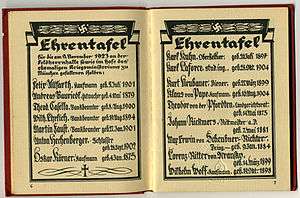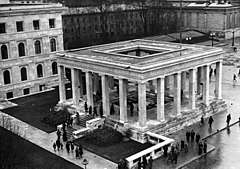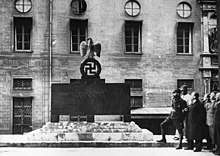Blutzeuge
Blutzeuge (German for "blood witness") was a term used in Nazi Germany for members of the National Socialist German Workers' Party (NSDAP) and associated organizations considered to be martyrs. Blutzeuge was used in Nazi propaganda in the 1930s and 1940s depicting a hero cult of "fallen" Nazis who had been murdered by opponents in the political violence in Germany during the Weimar Republic and after the seizure of control in January 1933. An early Nazi usage of the term was Adolf Hitler's dedication at the start of Mein Kampf, which he dedicated to the sixteen NSDAP members killed in the 1923 Beer Hall Putsch.[1]

A 1935 Nazi Party publication roll of honor list for members killed in the Beer Hall Putsch in 1923.
Notable Blutzeuge
_Cigaretten-Bilderdienst_USHMM_No_known_copyright_restriction_Hitlerputsch_Gefallenen_1923_Cropped.jpg)
According to the Nazi propaganda the 16 fallen National Socialists from the Beer Hall Putsch 1923 were the first "blood martyrs" of the Nazi Party.
- Wilhelm Gustloff, founder of the NSDAP/AO branch in Switzerland assassinated in 1936.
- Herbert Norkus, 15-year-old member of the Hitler Youth murdered in a fight with Roter Frontkämpferbund youths in 1932.
- Max Erwin von Scheubner-Richter, early prominent NSDAP member and close associate of Adolf Hitler killed in the Beer Hall Putsch in 1923.
- Albert Leo Schlageter, member of the Freikorps executed for sabotage in the Occupation of the Ruhr in 1923.
- Horst Wessel, leading member of the Sturmabteilung in Berlin assassinated in 1930.
Gallery

 Nazi memorial site for Blutzeugen in Munich, which could be bypassed by the "Drückebergergasse" ("quitters' alley").
Nazi memorial site for Blutzeugen in Munich, which could be bypassed by the "Drückebergergasse" ("quitters' alley").
gollark: You do know that an 8G one would require 256 CBs, right? Either that or 128.
gollark: 18 hours until the raffle drawing.
gollark: It's very mundane, but fits the scheme, and is better than `queenqueer` or just the code.
gollark: Make the adult one transparent pixel.
gollark: Traitor.
References
- Andreas Daum; Christof Mauch (26 December 2005). Berlin - Washington, 1800-2000: Capital Cities, Cultural Representation, and National Identities. Cambridge University Press. pp. 145–. ISBN 978-0-521-84117-7.
This article is issued from Wikipedia. The text is licensed under Creative Commons - Attribution - Sharealike. Additional terms may apply for the media files.